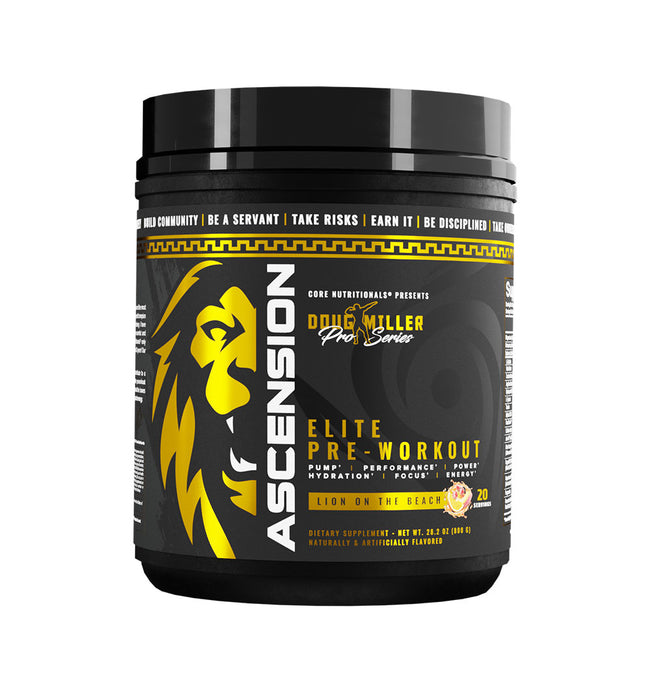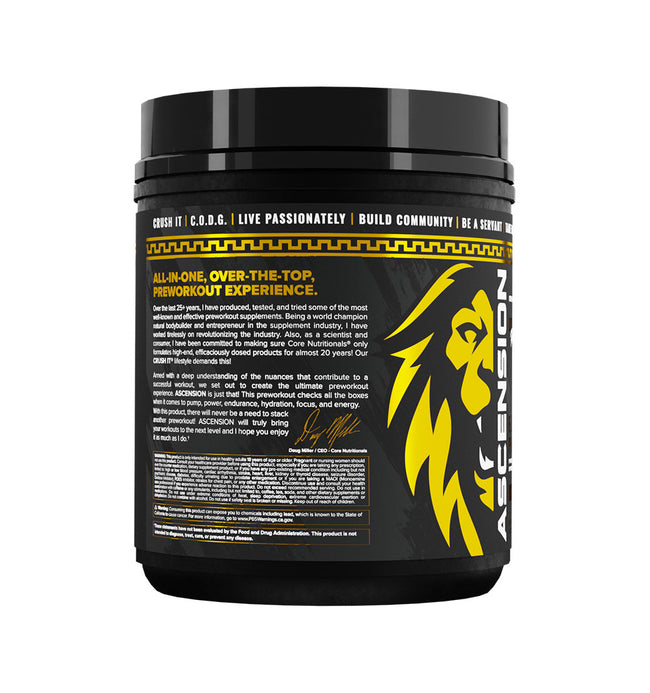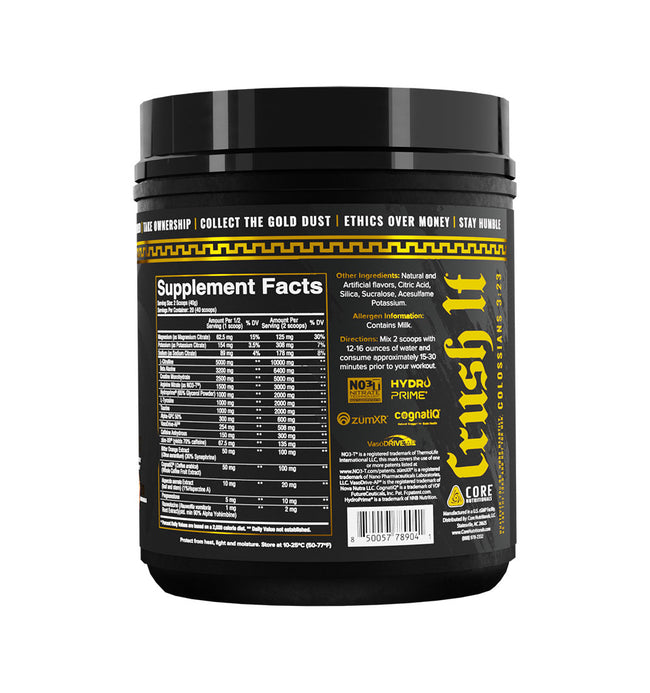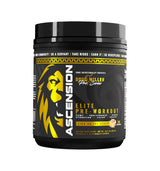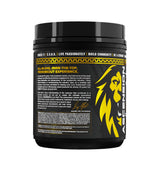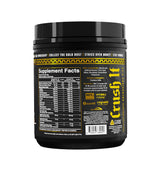ALL-IN-ONE, OVER-THE-TOP, PREWORKOUT EXPERIENCE.
Over the last 25+ years, I have produced, tested, and tried some of the most well-known and effective preworkout supplements. Being a world champion natural bodybuilder and entrepreneur in the supplement industry, I have worked tirelessly on revolutionizing the industry. Also, as a scientist and consumer, I have been committed to making sure Core Nutritionals® only formulates high-end, efficaciously dosed products for almost 20 years! Our CRUSH IT® Lifestyle demands this!
Armed with a deep understanding of the nuances that contribute to a successful workout, we set out to create the ultimate preworkout experience. ASCENSION is just that! This preworkout checks all the boxes when it comes to pump, power, endurance, hydration, focus, and energy. With this product, there will never be a need to stack another preworkout! ASCENSION will truly bring your workouts to the next level and I hope you enjoy it as much as I do.
L-Citrulline
Citrulline is a non-essential, non-protein amino acid that forms during the urea cycle and forms ornithine when combined with carbon dioxide. Citrulline is also a critical source of endogenous (natural) arginine, as it is rapidly and efficiently converted to arginine in the vascular endothelium and other tissues.
Citrulline’s benefits have been shown to be greater than its parent compound. While arginine undergoes direct hepatic (liver) metabolism through the enzyme arginase, citrulline bypasses hepatic metabolism entirely and it is delivered straight to the bloodstream. The result is that gut absorption and plasma (blood) bioavailability studies comparing citrulline and arginine have shown two things. First, citrulline is less readily destroyed and has greater absorption than arginine. Second, citrulline supplementation increases arginine levels more effectively than arginine supplementation itself.
This translates to promising results. For example, animal studies show a significant increase in anaerobic performance at a 250mg/kg/day serving of citrulline, while studies in humans implicate citrulline in both aerobic and anaerobic performance increases. As a critical part of the urea cycle, citrulline’s performance benefits are thought to be a result of its role in ammonia clearance. Citrulline is implicated in reducing the oxygen cost of muscle processes, along with increasing the rate of post-exercise ATP and phosphocreatine replenishment. As ATP and phosphocreatine are the body’s ‘exercise fuel,’ this may result in citrulline delaying time to exhaustion in aerobic and anaerobic exercise.
Beta Alanine
Carnosine, a critical compound for muscle function, has long intrigued researchers due to its essential role in buffering pH levels in muscle cells, particularly during intense exercise. However, efforts to increase intramuscular carnosine levels via direct supplementation faced challenges due to rapid degradation in the body. The introduction of beta-alanine, a precursor to carnosine, revolutionized this approach. Beta-alanine has proven to be highly effective in significantly increasing intramuscular carnosine concentrations, thereby unlocking carnosine's beneficial effects on muscle performance. Moreover, beta-alanine itself exhibits physiological benefits beyond its role as a carnosine precursor. By synthesizing carnosine from the precursors L-histidine and l-alanine, carnosine acts as a chemical buffer in muscle cells, crucial for sustained performance during intense exercise. Beta-alanine supplementation has demonstrated consistent and dose-dependent increases in intramuscular carnosine levels, particularly when combined with exercise. This synergy between beta-alanine and exercise promotes not only the direct physiological actions of beta-alanine but also enhances the production of intramuscular carnosine. Consequently, beta-alanine supplementation has been linked to improvements in various aspects of exercise performance, including increased total work capacity, enhanced endurance measured by total time to exhaustion (TTE), and elevated muscle power output. Additionally, beta-alanine supplementation has shown benefits for individuals engaging in power-dependent resistance training and exercising under hypoxic conditions. This comprehensive array of benefits positions beta-alanine as one of the most extensively studied and versatile dietary supplements for enhancing exercise performance and promoting muscle adaptations.
Creatine Monohydrate
Creatine, often hailed as the "grandfather" of dietary supplements, stands alongside caffeine as one of the most extensively researched compounds in the field. Renowned as the premier ergogenic aid, the wealth of data on creatine illustrates its multifaceted benefits. Primarily, it promotes vasodilation, facilitates nutrient mobilization, enhances nitrogen retention, and augments protein synthesis post-workout. Its prowess lies in its ability to dose-dependently elevate contractile force through ATP provision, essentially bolstering strength.
In the realm of cellular energy, ATP reigns supreme as the currency of the human body's bank account. Every cellular process, akin to spending, draws from this finite resource. Without replenishment, fatigue sets in, akin to an empty account. Though directly depositing exogenous ATP is unfeasible due to its instability, supplemental creatine serves as a surrogate, fostering ATP synthesis via a series of metabolic steps. Within skeletal muscle, creatine undergoes phosphorylation to produce phosphocreatine (PCr), catalyzed by creatine kinase-MB. Subsequently, PCr donates a phosphate group to ADP, swiftly generating ATP during intense muscular contractions. This not only amplifies contractile force but also recruits type IIx muscle fibers, known for their association with speed, strength, and muscle hypertrophy.
Clinical evidence consistently corroborates creatine's capacity to augment lean and muscle mass through ATP provision, nutrient mobilization, protein preservation, and fluid dynamics. Short-term gains often stem from extracellular fluid retention induced by creatine supplementation. Conversely, long-term benefits derive from its profound impact on muscle metabolism. Recent studies unveil creatine's direct modulation of muscle metabolism, including gene expression alterations, leucine breakdown attenuation, and cellular volume expansion. In simple terms, the creatine monohydrate content in products like Ascension delivers tangible results—significant gains in lean body mass, muscle volume, reduced fatigue, and enhanced performance, validated time and again by research.
Arginine Nitrate (as NO3-T®)
Nitric oxide (NO) is involved in many vascular and cellular functions as a signaling molecule for cellular respiration, vasodilation, and angiogenesis. NO is produced through both endogenous and exogenous pathways through dietary nitrate ingestion. Nitrates are converted to nitrite, which is then converted to nitric oxide. Found naturally in many foods such as leafy greens and beets, NO has a long history of scientific literature to back its potential effects as an ergogenic aid and other health-promoting effects. In terms of athletic performance, NO typically will make an impact through a few different mechanisms, such as:
- Delayed onset of fatigue.
- Increased nutrient and oxygen delivery to working muscles via increased vasodilation.
- Increased loss of metabolic by-products as a result of high intense exercise.
However, when it comes to exercise and utilizing NO for its benefits in athletic performance, consuming whole foods is not always the most optimal form, so dietary supplemental forms of nitrates are often used to help provide this benefit. There are several forms of supplemental nitrates on the market today but for this product we are utilizing arginine nitrate (NO3-T®). Arginine nitrate is a salt that is synthesized from adding nitric acid to arginine. Arginine is classically utilized for its blood flow and vasodilation improving benefits and when combined with a nitrate, these benefits get exponentially elevated. As discussed above, the pathways with which NO is produced are of the importance. Pairing arginine with the patented nitrate (N03-T®) enhances nitric oxide production via the nitrate-nitrite pathway. Organic nitrate esters have a direct relaxant effect on vascular smooth muscles through non-nitric oxide synthase pathways, being directly converted first to nitrites and then to nitric oxide itself. (With attendant increases to guanylyl cyclase and then cyclic guanosine monophosphate (cGMP), which relax the vasculature.) Pairing both nitric oxide synthase and non-nitric oxide synthase-dependent mechanisms of actions theoretically enhances total NO production, given that rate-limiting enzymatic pathways in either mechanism do not determine total NO production.
In an absolute sense, both inorganic and organic nitrates also possess benefits beyond a secondary NO-production pathway. Studies in athletes have demonstrated that nitrate ingestion prior to both aerobic and anaerobic exercise meaningfully increases both delay to fatigue and total work capacity – likely a consequence of nitrate’s activation in hypoxic (oxygen-deprived tissues). Nitrate effectively reduces the oxygen cost of muscular activity, making contractions more efficient.
Hydroprime® (65% Glycerol Powder)
Glycerol is a fascinating and highly useful compound that has achieved a somewhat cult status in the fitness community – while both peer-reviewed research and anecdotal reports centered on the endurance functions of glycerol are plentiful, its bodybuilding applications are not as widely lauded. Those who do use glycerol, however, are persistent in their belief that it provides some of the most noticeable, and effective, engorging (“pump”) effects possible.
Glycerol has been well-established as a so-called, “hyperhydrating agent” because of its ability to affect plasma (blood) osmolality potently and positively. As an incredibly powerful osmotic agent, and when combined with large quantities of water, glycerol induces the intracellular retention of fluid (not the extracellular kind, you do not want) that would otherwise be renally excreted. Various research has shown that glycerol’s capacity to positively affect osmolality and expand fluid volume (an increase in total body water) has beneficial effects on performance and physiologic function.
Studies that administered glycerol before both moderate and high endurance fitness tests found that glycerol reduced increases to core temperature, caused athletes to exercise significantly longer before fatigue, reduced urinary elimination of water and increased total body water content, and, in several studies, significantly improved intramuscular water expansion. In less complex terms, this means glycerol has been demonstrated to keep your muscles hydrated, significantly increase the ever desired, “pump effect” of muscle engorgement, and, maybe most importantly when it comes to a supplement formulation, deliver and keep more nutrients where they are needed (inside the muscle).
Until recently, however, most of these studies noted a significant drawback: the low glycerol concentration of market-available glycerol products forced researchers to test glycerol loads that were significantly higher than average use cases. ASCENSION uses HydroPrime® to overcome precisely this problem.
HydroPrime®, from NNB Nutrition, is a highly concentrated (65%) form of glycerol that offers greater water stability, and therefore potency, as compared to standard GMS (glycerol monostearate). Of particular interest to bodybuilders, HydroPrime®’s greater potency translates to even greater levels of intramuscular water retention – keyword, intramuscular, and therefore no bloat – over GMS.
Overall, supplementation with HydroPrime® has been shown to:
- Keep athletes hyperhydrated for extended periods of time.
- Reduce post-workout urine volume (more efficient fluid use).
- Lower heart rate and improve endurance time.
- Enhance plasma and intramuscular volume expansion.
L-Tyrosine
Tyrosine is amongst a class of amino acids known as ‘non-essential’ amino acids, so called because the body can produce them endogenously, and it is therefore not essential to consume dietary tyrosine. That said, tyrosine is also what is known as a conditionally essential amino acid; conditionally essential because, along with glucose and ammonia, the synthesis of tyrosine additionally requires adequate levels of phenylalanine. Once synthesized, tyrosine is one of the most critical amino acids, given its prominent role as a substrate in the synthesis of the catecholamines dopamine, norepinephrine, and epinephrine, in addition to both T3 (triiodothyronine) and T4 (thyroxine) thyroid hormones.
In studies on stress modulation, tyrosine has been demonstrated to reverse stress-induced norepinephrine depletion and the depressant-behavioral effects normally associated with it. In simpler terms, tyrosine may, in certain conditions, dampen the extent to which norepinephrine is removed from the bloodstream during a stress event. In simpler terms still, tyrosine may help to mitigate the sense of depletion and fatigue felt at the end of a workout.
Tyrosine may also play important metabolic functions, mostly related to its role in synthesizing compounds which stimulate the nervous system. While not traditionally considered a sympathomimetic amine, studies which have coadministered tyrosine and stimulants demonstrate a synergistic effect. These studies suggest that tyrosine may potentiate the effects of both endogenous and supplemental norepinephrine and its mimetics (in the case of exogenous use) with respect to lipolysis, thermogenesis, and energy expenditure. Meaning that tyrosine may play a role in assisting norepinephrine to break up triglycerides and increase body heat transiently.
L-Taurine
Traditionally referred to as an amino acid due to its chemical structure, taurine is not an amino acid in the sense that leucine, alanine, or glutamine are. Its chemical status aside, taurine is considered one of the body’s most essential chemical compounds, as cardiovascular function, muscle development and function, along with optical and nervous systems in the body depend on its abundance. While data on taurine typically occurs with taurine in supplement combinations (with caffeine and other amino acids), these data nevertheless suggest that dietary supplementation with taurine may have beneficial effects on mental focus and alertness and may assist during times of increased physical exertion.
Traditionally referred to as an amino acid due to its chemical structure, taurine is not an amino acid in the sense that leucine, alanine, or glutamine are. Its chemical status aside, taurine is considered one of the body’s most essential chemical compounds, as cardiovascular function, muscle development and function, along with optical and nervous systems in the body depend on its abundance. While data on taurine typically occurs with taurine in supplement combinations (with caffeine and other amino acids), these data nevertheless suggest that dietary supplementation with taurine may have beneficial effects on mental focus and alertness and may assist during times of increased physical exertion.
Alpha-GPC 50%
Among the various choline pro-drugs or precursors, Alpha GPC stands out for its significant impact on circulating choline levels. Choline, an essential nutrient, plays a crucial role in numerous metabolic pathways, including DNA regulation, protein function, and metabolism. Notably, choline serves as a precursor for the synthesis of acetylcholine, a critical neurotransmitter involved in various physiological functions, such as muscular contraction and cognitive processes like memory and learning. Animal studies have underscored the importance of choline in prenatal brain development, with maternal choline levels directly influencing offspring brain development, particularly in the hippocampus, a region vital for memory consolidation and learning in humans. Given choline's role as a substrate for acetylcholine synthesis, it may indirectly impact these cognitive processes. Recent research involving Alpha GPC supplementation has shown promising results in enhancing power output. In a placebo-controlled, double-blind, randomized trial involving healthy volunteers, those supplemented with Alpha GPC experienced a significant 14% increase in bench press performance compared to the placebo group. Researchers attribute this improvement to Alpha GPC's potential to acutely elevate growth hormone levels, highlighting its potential as an ergogenic aid in enhancing physical performance.
Vasodrive-AP®
Vasodrive-AP® is a patented dietary supplement ingredient composed of a precise blend of naturally derived peptides, primarily derived from casein hydrolysate. This ingredient has garnered attention for its potential benefits in enhancing exercise performance through its vasodilatory properties. Vasodrive-AP® works by promoting the release of nitric oxide (NO), a key signaling molecule involved in vasodilation, which leads to the relaxation of blood vessels and increased blood flow to exercising muscles. It does this through several mechanisms of action. First, the increase in the production of endothelial nitric oxide synthase (eNOS) improves arterial flexibility leading to enhanced blood flow. Second, Vasodrive-AP® can also inhibit the enzyme that leads to the constriction of blood vessels. By improving blood flow and oxygen delivery to working muscles, Vasodrive-AP® may enhance exercise capacity, delay the onset of fatigue, and improve overall performance during both endurance and resistance training activities. Additionally, the improved nutrient and oxygen delivery facilitated by Vasodrive-AP® may aid in muscle recovery post-exercise, potentially reducing muscle soreness and accelerating the repair process. While further research is needed to fully elucidate its mechanisms and optimal dosages, Vasodrive-AP® shows promise as a natural ergogenic aid for individuals seeking to maximize their exercise performance and recovery.
Caffeine Anhydrous
Caffeine is one of the most widely consumed, and perhaps one of the most reviewed, psychoactive compounds. Its physiological effects in a range of areas have been well-documented, including exercise performance, information processing, alertness and mood enhancement, attention, and awareness, along with its anti-lipogenic and lipolytic abilities.
Most importantly to ASCENSION, caffeine has been shown to have significant effects on exercise performance, even with ingestion in servings as small 3 to 9mg/kg/bw/day (the equivalent of 2 cups of standard coffee, for a 170lb male). In endurance training, possible explanations for caffeine’s performance-enhancing effects lie in its metabolic effects on both lean and fat tissue. It is suggested that caffeine’s potent lipolytic (the breakdown of fat tissue into fatty acids) and oxidative (the actual ‘burning’ of fat) action allow the body to utilize these sources during prolonged submaximal exercise. Consequently, muscle glycogen is spared and available for use later in the training session. Practically speaking, this means caffeine is forcing your body to preferentially use fat tissue as a fuel source, while sparing the glycogen which gives you the full-bodied look!
In short-term exercise, caffeine’s demonstrated role in the inhibition of cyclic AMP- phosphodiesterase’s (PDE), adenosine receptor antagonism, and adrenoreceptor agonism come into play. These three pathways collectively stimulate lipolytic activity, boost fat metabolism, increase metabolic rate and energy expenditure, and regulate the body’s thermogenic activity. The practical results of activating these pathways are increases to the contractile force of both cardiac and skeletal muscle (harder flexion), an increase in energy expenditure (freeing up more caloric energy to be used in contraction), dilation of vasculature (better blood flow), and improvements to both nitrogen retention and skeletal muscle protein synthesis (key components to muscle building).
Züm-XR® (yields 70% caffeine)
Züm-XR is a patented coating technology that allows the dissolution profile of certain ingredients, primarily caffeine, to have a longer lasting effect in blood serum levels. The release of those ingredients is initiated by an abrasion in the stomach and pH levels between the stomach and the upper gastrointestinal tract. The coating of the microbead technology is a patented timing system with pharmaceutical grade safe polymers. Comparatively speaking, the dissolution profile of Züm-XR caffeine to your typical immediate release caffeine showed that Züm-XR took a far greater amount of time, well over 120 minutes to complete the process of dissolution.
Bitter Orange Extract (Citrus aurantium) (30% synephrine)
Bitter orange extract, derived from the fruit of Citrus aurantium, contains a diverse array of bioactive compounds, notably including synephrine, flavonoids, and essential oils. Synephrine, the principal alkaloid in bitter orange extract, exhibits sympathomimetic properties, stimulating the sympathetic nervous system and potentially increasing heart rate, blood pressure, and metabolic rate. These effects have led to interest in bitter orange extract as a potential aid for weight management, with studies suggesting its ability to enhance thermogenesis, suppress appetite, and stimulate lipolysis. The flavonoids present in bitter orange extract contribute antioxidant activity, which may offer additional health benefits by protecting cells from oxidative damage. Additionally, the combination of caffeine and synephrine appears to potentiate each ingredient’s effects – with rates of fatty acid liberation, heart rate, metabolic rate, and fatty acid oxidation increased in clinical trials featuring the combination. In several studies utilizing other forms of synephrine, it was found that the combination of synephrine and caffeine led to a small but significant reduction in fat mass of 3lbs, and a reduction in bodyfat of 2.9%.
CognatiQ® (Coffea arabica) (Whole Coffee Fruit Extract)
CognatiQ®, an extract derived from the whole fruit Coffea arabica plant, is a clinically proven ingredient shown to stimulate the production of the neuroprotein, Brain-Derived Neurotrophic Factor (BDNF). BDNF has been shown to be crucial in the development, maintenance and repair of neurons and also protect against neurodegeneration. One study comparing other coffee, caffeine, and polyphenol compounds, showed that they were not statistically significant in increasing BDNF % compared to CognatiQ®. The unique polyphenol profile found in CognatiQ® showed to be superior in increasing BDNF concentration.
Huperzia serrata Extract (Leaf and Stem) (1% Huperzine A)
Huperzia serrata, a compound found in plant families such as Huperziaceae, Lycopodiaceae, and Selaginella, is native to China. The Lycopodium alkaloid Huperzine-A, present in Core ASCENSION, was initially extracted from a traditional medicinal preparation in 1984.
Due to its potent anticholinesterase properties, Huperzine A has been extensively studied in various in vitro, in vivo, and human trials. Research indicates that its actions are most pronounced in the cortex, hippocampus, and striatum, crucial brain regions involved in memory formation, coordination, and recall, particularly in rodents. Furthermore, Huperzine A boasts high oral bioavailability, enhancing its efficacy. Studies utilizing microdialysis techniques in rats have demonstrated dose-dependent responses to Huperzine A, leading to significant reductions in acetylcholine levels in the cortex.
Human studies have also shown promising results. In one investigation involving middle school students experiencing memory inadequacies, pairs of students were administered a small dose of Huperzine A and then subjected to tests measuring working memory. The results indicated a notable improvement in memory function among adolescent students who received Huperzine A supplementation.
Pregnenolone
Pregnenolone, or pregn-5-en-3β-ol-20-one, is known as the grandmother hormone due to its precursor role in the endogenous biosynthesis of most steroid hormones. Pregnenolone also has potent intrinsic activity, however, functioning as a neurosteroid. In that capacity, pregnenolone has been investigated as a mechanistically novel agent for treating cognitive and behavioral symptoms associated with schizophrenia and other mood disorders.
Pregnenolone has been demonstrated to enhance learning and memory in animal models at physiologically relevant concentrations. For example, acute administration of pregnenolone or pregnenolone sulfate to rodents results in increased performance along several standardized tests – including maze tests given to rodents to test working memory. Additionally, pregnenolone appears to prevent learning and memory deficits induced by NDMA receptor agonists. These results suggest that pregnenolone’s cognitive functions are at least partially explained by modulating the NMDA receptors – critical receptors involved in numerous neurological processes.
Rauwolscine (Rauwolfia vomitoria Root Extract) (std. min 90% Alpha Yohimbine)
Alpha Yohimbine, also known as rauwolscine, offers several potential benefits, particularly in the realm of sports performance as well as weight management. As a dietary supplement, it is often touted for its ability to enhance fat loss and promote energy expenditure, making it popular amongst many athletes. Alpha Yohimbine exhibits a mechanism of action that works to antagonize alpha-2 adrenergic receptors, which can lead to increased lipolysis, which is the breakdown of stored fatty acids that can then be used as a fuel source for the body. This utilization of fatty acids for energy can support weight loss and management, thus improving overall body composition. It’s essential to note that while Alpha Yohimbine shows promise, more research is needed to fully understand its effects.



